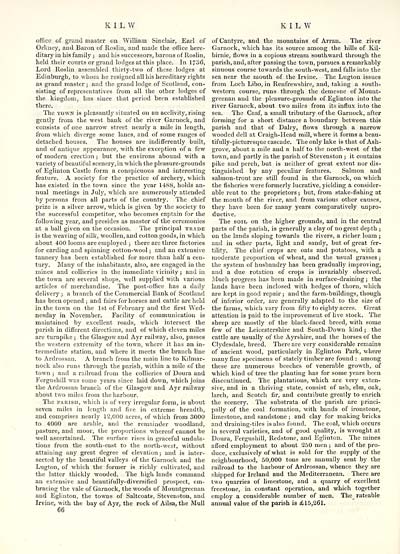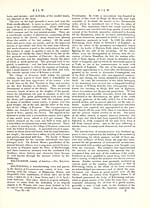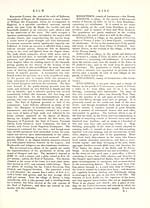Topographical dictionary of Scotland > Volume 2
(74) Page 66 - KIL
Download files
Complete book:
Individual page:
Thumbnail gallery: Grid view | List view

KILW
KILW
office of grand master on William Sinclair, Earl of
Orkney, and Baron of Roslin, and made the office here-
ditary in his family ; and his successors, barons of Roslin,
held their courts or grand lodges at this place. In 1736,
Lord Roslin assembled thirty-two of these lodges at
Edinburgh, to whom he resigned all his hereditary rights
as grand master ; and the grand lodge of Scotland, con-
sisting of representatives from all the other lodges of
the kingdom, has since that period been established
there.
The town is pleasantly situated on an acclivity, rising
gently from the west bank of the river Garnock, and
consists of one narrow street nearly a mile in length,
from which diverge some lanes, and of some ranges of
detached houses. The houses are indifferently built,
and of antique appearance, with the exception of a few
of modern erection ; but the environs abound with a
variety of beautiful scenery, in which the pleasure-grounds
of Eglinton Castle form a conspicuous and interesting
feature. A society for the practice of archery, which
has existed in the town since the year 148S, holds an-
nual meetings in July, which are numerously attended
by persons from all parts of the country. The chief
prize is a silver arrow, which is given by the society to
the successful competitor, who becomes captain for the
following year, and presides as master of the ceremonies
at a ball given on the occasion. The principal trade
is the weaving of silk, woollen, and cotton goods, in which
about 400 looms are employed ; there are three factories
for carding and spinning cotton-wool ; and an extensive
tannery has been established for more than half a cen-
tury. Many of the inhabitants, also, are engaged in the
mines and collieries in the immediate vicinity ; and in
the town are several shops, well supplied with various
articles of merchandise. The post-office has a daily
delivery ; a branch of the Commercial Bank of Scotland
has been opened ; and fairs for horses and cattle are held
in the town on the 1st of February and the first Wed-
nesday in November. Facility of communication is
maintained by excellent roads, which intersect the
parish in different directions, and of which eleven miles
are turnpike ; the Glasgow and Ayr railway, also, passes
the western extremity of the town, where it has an in-
termediate station, and where it meets the branch line
to Ardrossan. A branch from the main line to Kilmar-
nock also runs through the parish, within a mile of the
town j and a railroad from the collieries of Doura and
Fergushill was some years since laid down, which joins
the Ardrossan branch of the Glasgow and Ayr railway
about two miles from the harbour.
The parish, which is of very irregular form, is about
seven miles in length and five in extreme breadth,
and comprises nearly 12,000 acres, of which from 3000
to 4000 are arable, and the remainder woodland,
pasture, and moor, the proportions whereof cannot be
well ascertained. The surface rises in graceful undula-
tions from the south-east to the north-west, without
attaining any great degree of elevation; and is inter-
sected by the beautiful valleys of the Garnock and the
Lugton, of which the former is richly cultivated, and
the latter thickly wooded. The high lands command
an extensive and beautifully- diversified prospect, em-
bracing the vale of Garnock, the woods of Mountgreenan
and Eglinton, the towns of Saltcoats, Stevenston, and
Irvine, with the bay of Ayr, the rock of Ailsa, the Mull
of Cantyre, and the mountains of Arran. The river
Garnock, which has its source among the hills of Kil-
birnie, flows in a copious stream southward through the
parish, and, after passing the town, pursues a remarkably
sinuous course towards the south-west, and falls into the
sea near the mouth of the Irvine. The Lugton issues
from Loch Libo, in Renfrewshire, and, taking a south-
western course, runs through the demesne of Mount-
greenan and the pleasure-grounds of Eglinton into the
river Garnock, about two miles from its influx into the
sea. The Caaf, a small tributary of the Garnock, after
forming for a short distance a boundary between this
parish and that of Dairy, flows through a narrow
wooded dell at Craigh-Head mill, where it forms a beau-
tifully-picturesque cascade. The only lake is that of Ash-
grove, about a mile and a half to the north-west of the
town, and partly in the parish of Stevenston ; it contains
pike and perch, but is neither of great extent nor dis-
tinguished by any peculiar features. Salmon and
salmon-trout are still found in the Garnock, on which
the fisheries were formerly lucrative, yielding a consider-
able rent to the proprietors ; but, from stake-fishing at
the mouth of the river, and from various other causes,
they have been for many years comparatively unpro-
ductive.
The soil on the higher grounds, and in the central
parts of the parish, is generally a clay of no great depth ;
on the lands sloping towards the rivers, a richer loam ;
and in other parts, light and sandy, but of great fer-
tility. The chief crops are oats and potatoes, with a
moderate proportion of wheat, and the usual grasses ;
the system of husbandry has been gradually improving,
and a due rotation of crops is invariably observed.
Much progress has been made in surface-draining ; the
lands have been inclosed with hedges of thorn, which
are kept in good repair ; and the farm-buildings, though
of inferior order, are generally adapted to the size of
the farms, which vary from fifty to eighty acres. Great
attention is paid to the improvement of live stock. The
sheep are mostly of the black-faced breed, with some
few of the Leicestershire and South-Down kind ; the
cattle are usually of the Ayrshire, and the horses of the
Clydesdale, breed. There are very considerable remains
of ancient wood, particularly in Eglinton Park, where
many fine specimens of stately timber are found : among
these are numerous beeches of venerable growth, of
which kind of tree the planting has for some years been
discontinued. The plantations, which are very exten-
sive, and in a thriving state, consist of ash, elm, oak,
larch, and Scotch fir, and contribute greatly to enrich
the scenery. The substrata of the parish are princi-
pally of the coal formation, with bands of ironstone,
limestone, and sandstone ; and clay for making bricks
and draining-tiles is also found. The coal, which occurs
in several varieties, and of good quality, is wrought at
Doura, Fergushill, Redstone, and Eglinton. The mines
afford employment to about 250 men ; and of the pro-
duce, exclusively of what is sold for the supply of the
neighbourhood, 50,000 tons are annually sent by the
railroad to the harbour of Ardrossan, whence they are
shipped for Ireland and the Mediterranean. There are
two quarries of limestone, and a quarry of excellent
freestone, in constant operation, and which together
employ a considerable number of men. The^ rateable
annual value of the parish is £15,261.
KILW
office of grand master on William Sinclair, Earl of
Orkney, and Baron of Roslin, and made the office here-
ditary in his family ; and his successors, barons of Roslin,
held their courts or grand lodges at this place. In 1736,
Lord Roslin assembled thirty-two of these lodges at
Edinburgh, to whom he resigned all his hereditary rights
as grand master ; and the grand lodge of Scotland, con-
sisting of representatives from all the other lodges of
the kingdom, has since that period been established
there.
The town is pleasantly situated on an acclivity, rising
gently from the west bank of the river Garnock, and
consists of one narrow street nearly a mile in length,
from which diverge some lanes, and of some ranges of
detached houses. The houses are indifferently built,
and of antique appearance, with the exception of a few
of modern erection ; but the environs abound with a
variety of beautiful scenery, in which the pleasure-grounds
of Eglinton Castle form a conspicuous and interesting
feature. A society for the practice of archery, which
has existed in the town since the year 148S, holds an-
nual meetings in July, which are numerously attended
by persons from all parts of the country. The chief
prize is a silver arrow, which is given by the society to
the successful competitor, who becomes captain for the
following year, and presides as master of the ceremonies
at a ball given on the occasion. The principal trade
is the weaving of silk, woollen, and cotton goods, in which
about 400 looms are employed ; there are three factories
for carding and spinning cotton-wool ; and an extensive
tannery has been established for more than half a cen-
tury. Many of the inhabitants, also, are engaged in the
mines and collieries in the immediate vicinity ; and in
the town are several shops, well supplied with various
articles of merchandise. The post-office has a daily
delivery ; a branch of the Commercial Bank of Scotland
has been opened ; and fairs for horses and cattle are held
in the town on the 1st of February and the first Wed-
nesday in November. Facility of communication is
maintained by excellent roads, which intersect the
parish in different directions, and of which eleven miles
are turnpike ; the Glasgow and Ayr railway, also, passes
the western extremity of the town, where it has an in-
termediate station, and where it meets the branch line
to Ardrossan. A branch from the main line to Kilmar-
nock also runs through the parish, within a mile of the
town j and a railroad from the collieries of Doura and
Fergushill was some years since laid down, which joins
the Ardrossan branch of the Glasgow and Ayr railway
about two miles from the harbour.
The parish, which is of very irregular form, is about
seven miles in length and five in extreme breadth,
and comprises nearly 12,000 acres, of which from 3000
to 4000 are arable, and the remainder woodland,
pasture, and moor, the proportions whereof cannot be
well ascertained. The surface rises in graceful undula-
tions from the south-east to the north-west, without
attaining any great degree of elevation; and is inter-
sected by the beautiful valleys of the Garnock and the
Lugton, of which the former is richly cultivated, and
the latter thickly wooded. The high lands command
an extensive and beautifully- diversified prospect, em-
bracing the vale of Garnock, the woods of Mountgreenan
and Eglinton, the towns of Saltcoats, Stevenston, and
Irvine, with the bay of Ayr, the rock of Ailsa, the Mull
of Cantyre, and the mountains of Arran. The river
Garnock, which has its source among the hills of Kil-
birnie, flows in a copious stream southward through the
parish, and, after passing the town, pursues a remarkably
sinuous course towards the south-west, and falls into the
sea near the mouth of the Irvine. The Lugton issues
from Loch Libo, in Renfrewshire, and, taking a south-
western course, runs through the demesne of Mount-
greenan and the pleasure-grounds of Eglinton into the
river Garnock, about two miles from its influx into the
sea. The Caaf, a small tributary of the Garnock, after
forming for a short distance a boundary between this
parish and that of Dairy, flows through a narrow
wooded dell at Craigh-Head mill, where it forms a beau-
tifully-picturesque cascade. The only lake is that of Ash-
grove, about a mile and a half to the north-west of the
town, and partly in the parish of Stevenston ; it contains
pike and perch, but is neither of great extent nor dis-
tinguished by any peculiar features. Salmon and
salmon-trout are still found in the Garnock, on which
the fisheries were formerly lucrative, yielding a consider-
able rent to the proprietors ; but, from stake-fishing at
the mouth of the river, and from various other causes,
they have been for many years comparatively unpro-
ductive.
The soil on the higher grounds, and in the central
parts of the parish, is generally a clay of no great depth ;
on the lands sloping towards the rivers, a richer loam ;
and in other parts, light and sandy, but of great fer-
tility. The chief crops are oats and potatoes, with a
moderate proportion of wheat, and the usual grasses ;
the system of husbandry has been gradually improving,
and a due rotation of crops is invariably observed.
Much progress has been made in surface-draining ; the
lands have been inclosed with hedges of thorn, which
are kept in good repair ; and the farm-buildings, though
of inferior order, are generally adapted to the size of
the farms, which vary from fifty to eighty acres. Great
attention is paid to the improvement of live stock. The
sheep are mostly of the black-faced breed, with some
few of the Leicestershire and South-Down kind ; the
cattle are usually of the Ayrshire, and the horses of the
Clydesdale, breed. There are very considerable remains
of ancient wood, particularly in Eglinton Park, where
many fine specimens of stately timber are found : among
these are numerous beeches of venerable growth, of
which kind of tree the planting has for some years been
discontinued. The plantations, which are very exten-
sive, and in a thriving state, consist of ash, elm, oak,
larch, and Scotch fir, and contribute greatly to enrich
the scenery. The substrata of the parish are princi-
pally of the coal formation, with bands of ironstone,
limestone, and sandstone ; and clay for making bricks
and draining-tiles is also found. The coal, which occurs
in several varieties, and of good quality, is wrought at
Doura, Fergushill, Redstone, and Eglinton. The mines
afford employment to about 250 men ; and of the pro-
duce, exclusively of what is sold for the supply of the
neighbourhood, 50,000 tons are annually sent by the
railroad to the harbour of Ardrossan, whence they are
shipped for Ireland and the Mediterranean. There are
two quarries of limestone, and a quarry of excellent
freestone, in constant operation, and which together
employ a considerable number of men. The^ rateable
annual value of the parish is £15,261.
Set display mode to: Large image | Transcription
Images and transcriptions on this page, including medium image downloads, may be used under the Creative Commons Attribution 4.0 International Licence unless otherwise stated. ![]()
| Gazetteers of Scotland, 1803-1901 > Topographical dictionary of Scotland > Volume 2 > (74) Page 66 - KIL |
|---|
| Permanent URL | https://digital.nls.uk/97362017 |
|---|
| Description | Volume II: From Keanlochbervie to Zetland. |
|---|---|
| Attribution and copyright: |
|

